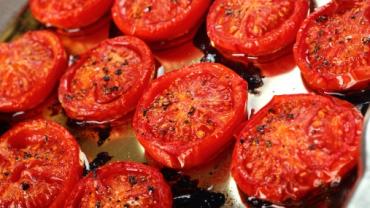
It isn’t every day that you find out a processed food product might offer more nutrients than its unprocessed counterpart. But that is exactly the case when it comes to the lycopene content of tomato paste and ketchup versus that of fresh tomatoes. Lycopene is a reddish carotenoid found in fruits and vegetables such as tomatoes red peppers watermelon guava and pink grapefruit. And it’s true that the bioavailability of lycopene from tomato paste is higher than that of fresh tomatoes.
The explanation for this seemingly odd occurrence is that the processing of tomatoes into thick concentrated paste may result in the lycopene being converted mostly to the cis isomer which is how lycopene presents in human serum and tissue whereas fresh tomatoes and some other tomato products contain all trans-lycopene.
Another surprising fact about lycopene is that temperature and time may affect the concentration of this nutrient in foods. For example compared to fresh-picked watermelon watermelons stored for 14 days at 21 degrees Celsius (almost 70 degrees Fahrenheit) had increases in lycopene of 11-40%. (The beta-carotene content increased by a whopping 50-139%!)
The good news is lycopene doesn’t just taste good. It’s also a potent antioxidant with more powerful free radical scavenging capacity than beta-carotene and alpha-tocopherol. One area of the body that may particularly benefit from lycopene is the skin. In one study upon exposure to sunlight-simulating ultraviolet (UV) light significantly more skin lycopene was destroyed than beta-carotene even when beta-carotene concentrations had been elevated by a high-dose supplement. Compared to non-exposed skin areas of skin exposed to the UV light showed 31-46% reductions in lycopene leading researchers to conclude that lycopene is a major mitigating factor in photo-damage to the skin. Regular consumption of lycopene-rich foods has been shown to decrease skin sensitivity to UV-induced sunburn. So maybe consuming red and pink produce can help your skin from turning red or pink!
Protection from sunburn might be the most mild potential benefit of lycopene. Lycopene also shines when it comes to protecting DNA from the damaging effects of ionizing radiation. Daily consumption of 60g of tomato puree for 3 weeks strengthens the resistance of lymphocyte DNA to oxidative stress. Because the bioavailability of lycopene from tomato puree is so high even as little as 25g/day was enough to raise plasma lycopene levels. Aside from its antioxidant capacity lycopene also influences tight junctions and facilitates cell-to-cell communication. Researchers believe this may play a role in lycopene’s demonstrated anti-cancer properties.
As if all that wasn’t enough lycopene has also been shown to be hypocholesterolemic . Supplementation with 60mg/day of lycopene led to a 14% reduction in plasma LDL cholesterol in a small study of healthy males. Lycopene has a mild suppressive effect on HMGCoA reductase the rate-limiting enzyme in endogenous cholesterol synthesis which would explain its cholesterol-lowering properties. Lycopene may also increase LDL receptor synthesis and the resulting increased cellular uptake of cholesterol would be another mechanism by which this carotenoid might reduce plasma cholesterol levels.
Like all carotenoids lycopene is fat-soluble and is best absorbed when consumed with fat. This isn’t license to eat pepperoni pizza but when tomatoes are at their peak in summer it certainly might be beneficial to drizzle some olive oil over roasted tomatoes with a sprinkling of sea salt and chopped fresh basil. In fact the antioxidant properties of lycopene exhibit a synergistic effect when combined with other antioxidants found in common culinary herbs. Compared to incubation with lycopene alone LDL particles incubated with lycopene (from tomatoes) garlic and rosmarinic and carnosic acids (from rosemary) showed impressively reduced oxidative damage upon exposure to copper sulfate as an oxidizing agent. Maybe the Italian nonnas who made these ingredients regular parts of their cooking throughout the ages knew something modern science is now confirming: these delicious foods are good for us too!